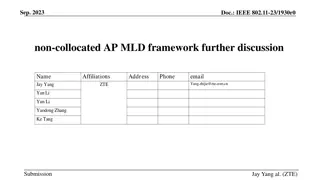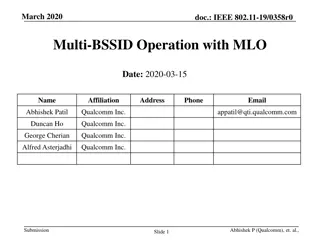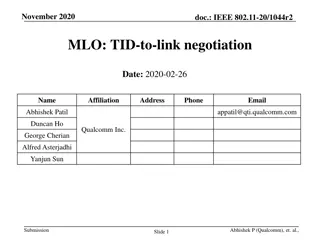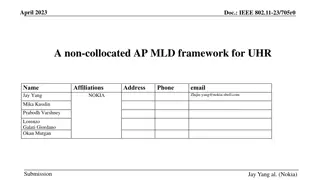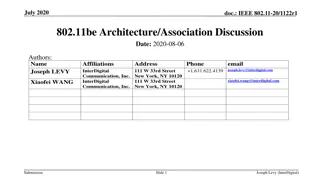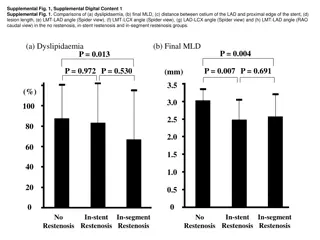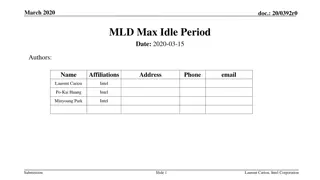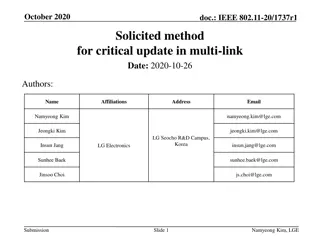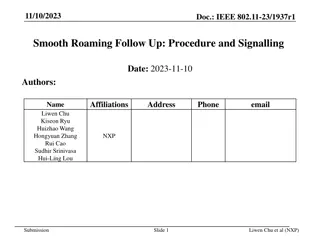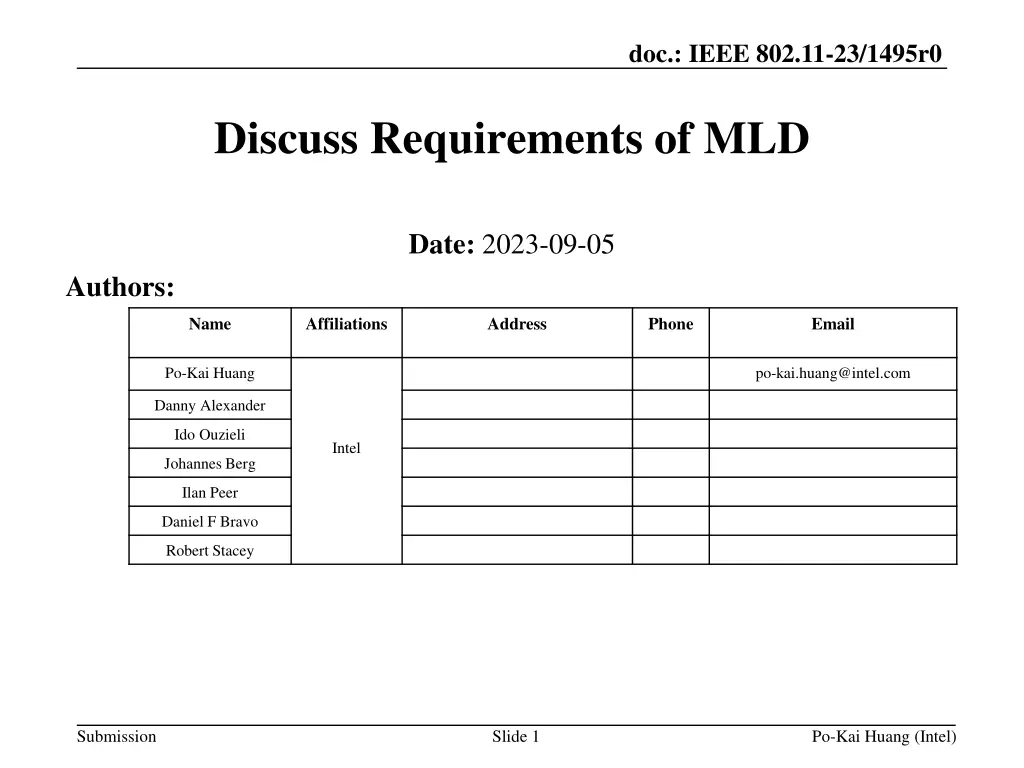
Requirements of MLD for IEEE 802.11-23/1495r0
Discuss the requirements of MLD (Medium Access Control Layer Design) for the IEEE 802.11-23/1495r0 standard, including the debate on mandating MLD for 11bi devices and implications of features related to group 1 and group 2. The presentation addresses the need for MLD compliance in devices supporting MAC address changes and encryption of data frames to ensure seamless connectivity and security.
Download Presentation

Please find below an Image/Link to download the presentation.
The content on the website is provided AS IS for your information and personal use only. It may not be sold, licensed, or shared on other websites without obtaining consent from the author. If you encounter any issues during the download, it is possible that the publisher has removed the file from their server.
You are allowed to download the files provided on this website for personal or commercial use, subject to the condition that they are used lawfully. All files are the property of their respective owners.
The content on the website is provided AS IS for your information and personal use only. It may not be sold, licensed, or shared on other websites without obtaining consent from the author.
E N D
Presentation Transcript
doc.: IEEE 802.11-23/1495r0 Discuss Requirements of MLD Date: 2023-09-05 Authors: Name Affiliations Address Phone Email Po-Kai Huang po-kai.huang@intel.com Danny Alexander Ido Ouzieli Intel Johannes Berg Ilan Peer Daniel F Bravo Robert Stacey Submission Slide 1 Po-Kai Huang (Intel)
doc.: IEEE 802.11-23/1495r0 Background There is a debate on whether we should mandate MLD for 11bi A question Should CPE and BPE devices be MLD-compliant? is included in [1] The debate starts to delay the progress of 11bi on spec texts writing We discuss this issue in this presentation Submission Slide 2 Po-Kai Huang (Intel)
doc.: IEEE 802.11-23/1495r0 Original Motivation for the discussion Due to the change of STA MAC address while associated, a non- MLD device will need to change the encryption of data frame when the MAC address is changed However, change of data frame encryption may not be viable for certain architectures with external key-holder [2] As a result, it is required to have a mechanism similar to the one introduced in 11be that uses MLD MAC address in AAD for the encryption of data frame The observation then leads to discussion whether we should just mandate MLD without defining another similar mechanism or define another mechanism similar to MLD The debate then propagates to most of the features in 11bi Submission Slide 3 Po-Kai Huang (Intel)
doc.: IEEE 802.11-23/1495r0 Discuss implication of 11bi features Generally, there are two groups of 11bi features Group 1: features that only need software change Minimize Probe Request element 802.1X authentication using authentication frame Password identifier privacy PMKID privacy Key negotiation in Authentication to protect (Re)Association Request/Response Encrypt (Re)Association Request/Response Include DS MAC address in encrypted (Re)Association Request Introduce protected version of current unencrypted management frame Protected action frame to request capabilities and operation parameters Group 2: features that require hardware change Change of STA MAC address/SN/PN/AID while associated Many Other parameters change while associated and BPN features The question in hand seems to be only related to the features in group 2. Further, implementation of group 1 features does not mean implementation of group 2 features is required Due to the possibility that hardware support depends on hardware refresh cycle As a result, we propose that we allow MLD and non-MLD for group 1 features and focus the discussion on the following revised question Shall 11bi devices that support STA MAC address change while associated support MLD? Slide 4 Submission Po-Kai Huang (Intel)
doc.: IEEE 802.11-23/1495r0 Illustration for MLD with STA MAC address change Initial connection for a non-AP MLD Authentication frame exchange with STA MAC address 1, MLD MAC address 1 Derive PTKSA using MLD MAC address 1 Encrypt association request with DS MAC address 1 and encrypt association response AAD Swap based on MLD MAC address 1 Change STA MAC address from 1 to X (similarly for other links if exists) Disassociation Follow up connection for a non-AP MLD Authentication frame exchange with STA MAC address 2, MLD MAC address 2 Derive PTKSA using MLD MAC address 2 Encrypt (re)association request with DS MAC address 1 and encrypt (re)association response AAD Swap based on MLD MAC address 2 Change STA MAC address from 2 to X (similarly for other links if exists) Disassociation 11bi STA MAC address change while associated can be an independent feature [3] Slide 5 Submission Po-Kai Huang (Intel)
doc.: IEEE 802.11-23/1495r0 Illustration for non-MLD with STA MAC address change Initial connection for a non-AP STA Authentication frame exchange with STA MAC address 1 Derive PTKSA using STA MAC address 1 Encrypt association request with DS MAC address 1 and encrypt association response AAD Swap based on ??? Change STA MAC address from 1 to X (questions on PTKSA still based on STA MAC address 1?) Disassociation Follow up connection for a non-AP STA Authentication frame exchange with STA MAC address 2 Derive PTKSA using STA MAC address 2 Encrypt (re)association request with DS MAC address 1 and encrypt (re)association response AAD Swap based on ??? Change STA MAC address from 2 to X (questions on PTKSA still based on STA MAC address 2?) Disassociation 11bi STA MAC address change while associated needs to solve the questions above Submission Slide 6 Po-Kai Huang (Intel)
doc.: IEEE 802.11-23/1495r0 Discuss two options for non-MLD Two options are on the table for AAD swap: Option 1: Simply mandate support of MLD for 11bi device that support STA MAC address change while associated Option 2: Develop some mechanisms to solve the questions Discussion on option 1: Simplify the hardware support on AP since MLD support is mandatory in 11be and increase the chance for wide support of the feature MLD support for client is there in 11be based on discussion with chip vendor even for low cost client Simplify the spec work and no need to duplicate texts of similar features Client can setup only one link using MLD and no need to implement most of the optional features Hardware features usually take longer to be adopted and by that time, 11be is likely already the mainstream when the hardware support is available, which means that option 2 may not be useful anymore. Before hardware support is there, group 1 features can be rolled out first to start provide privacy benefits Discussion on option 2: Can change STA MAC address while associated without implementing MLD Need to implement MLD like AAD swap, which requires additional hardware change for non-MLD Option 1 seems to be a better direction for 11bi Slide 7 Submission Po-Kai Huang (Intel)
doc.: IEEE 802.11-23/1495r0 Conclusion We think the question Should CPE and BPE devices be MLD-compliant? included in [1] should be changed to Shall 11bi devices that support STA MAC address change while associated support MLD? We propose the following: Software related features can be done for both MLD and non-MLD Mandate MLD support if 11bi devices support STA MAC address change while associated Submission Slide 8 Po-Kai Huang (Intel)
doc.: IEEE 802.11-23/1495r0 Straw Poll Do you support the following: 11bi devices that support the following features and do not support STA MAC address change while associated can be MLD or non-MLD Minimize Probe Request element 802.1X authentication using authentication frame Password identifier privacy PMKID privacy Key negotiation in Authentication to protect (Re)Association Request/Response Encrypt (Re)Association Request/Response Include DS MAC address in encrypted (Re)Association Request Introduce protected version of current unencrypted management frame Protected action frame to request capabilities and operation parameters Submission Slide 9 Po-Kai Huang (Intel)
doc.: IEEE 802.11-23/1495r0 Straw Poll Do you support the following: 11bi devices that support STA MAC address change while associated shall support MLD Submission Slide 10 Po-Kai Huang (Intel)
doc.: IEEE 802.11-23/1495r0 Reference [1] 11-23/892r2 Requirements and Issues Tracking [2] 11-20/1545r1 MLD security considerations [3] 11-23/873r2 Client Frame Tracking Countermeasures Submission Slide 11 Po-Kai Huang (Intel)

